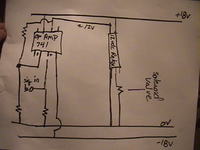NortonTriumph
Newbie level 3

stabilize signal
Hello,
I have a circuit that switches a solenoid. My models all incorporated a stable 1.8vdc input signal. The true signal is taken from a blinking diode circuit and it goes 0-1V.
I believe this confuses the Op-Amp 741 and it cannot handle this. Can someone shoot me in the right direction of tools to stabilize this signal. I am aware capacitors, resistors, filters are possibilities but don't know the approach. I may look for a stable signal source but it may be hard to find.
Thanks
Hello,
I have a circuit that switches a solenoid. My models all incorporated a stable 1.8vdc input signal. The true signal is taken from a blinking diode circuit and it goes 0-1V.
I believe this confuses the Op-Amp 741 and it cannot handle this. Can someone shoot me in the right direction of tools to stabilize this signal. I am aware capacitors, resistors, filters are possibilities but don't know the approach. I may look for a stable signal source but it may be hard to find.
Thanks


